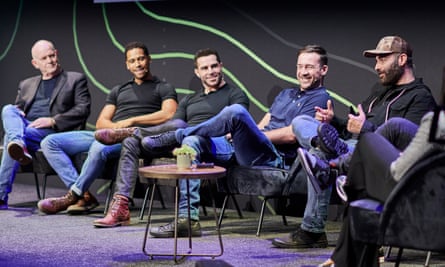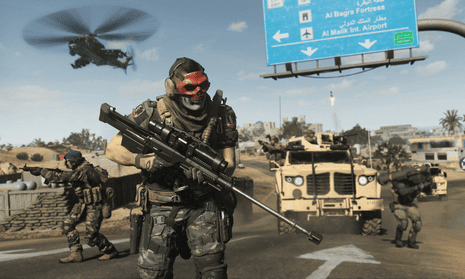The Call of Duty series is the action-movie blockbuster of the video game world. Loud, violent and filled with crazy stunts, these globetrotting military romps put their fictitious heroes through incredible physical danger, usually involving plane crashes, collapsing skyscrapers and vast firefights on sinking cruise liners.
So what is it like to actually star in one?
The latest Call of Duty title is Modern Warfare II, the second instalment in Activision’s reboot of the Modern Warfare series from the 2010s. For this globetrotting spec ops adventure, featuring franchise heroes Price, Gaz, Ghost and Soap on the trail of stolen nuclear weapons and Iranian terrorists, developer Infinity Ward assembled a cast of 15 actors, most with movie and TV experience, and filmed them over several months in the developer’s own motion capture studio in Woodland Hills, California. Although the actors are not having to actually perform stunts or film on location all over the world, the process has had challenges and idiosyncrasies they’ve had to learn to cope with. Not least, the outfits.
For cinematic scenes in big titles such as Call of Duty, the Last of Us and Death Stranding, actors now wear full performance-capture body suits – sort of like Lycra body gloves – which record their every movement. “I’ve been asked to play more than one general,” says actor Glenn Moreshower, who plays hard guy military chief, General Shepard, “but this is the only time I’ve done it wearing a leotard.” According to him, however, the biggest issue is the high definition camera he has to wear, which is fixed to a tripod on every actor’s helmet, pointing into their faces to capture every micro-expression. Recently, narrative director Jeffrey Negus tweeted a photo from the studio, which shows the suits and the cameras:
On location in Las Almas #ModernWarfareII @InfinityWard @thealainmesa@MariaECamargo @BayardoDe
— Jeffrey Keith Negus (@negusaurusrex) October 25, 2022
(Brian Bloom) pic.twitter.com/XwqjiyN0wt
“Doing video games is far more challenging than film for a number of reasons, but the biggest hurdle is the presence of that helmet cam,” says Moreshower. “Annoying is the word that comes to mind. If that was present on a movie, you’d go batshit crazy. But then you realise that whether you like it or not, it’s going to be there and you have to find a way to focus on your scene partner’s eyes and live in a world where that camera no longer exists.”
Barry Sloane, who plays artfully bearded SAS veteran Captain Price, had to do many of his scenes with a magic marker in his mouth to represent the character’s trademark cigar. He too found the camera a difficult distraction. “It’s a very unflattering angle,” he says. “At best, I look like Pete Townshend from the Who. At worst, a smurf.”
Most performers compare the experience of acting in a video game to theatre. There’s that same sense of having to mentally transform a bare space into a real location, and then projecting that to the audience; there’s a lot of very Stanislavskian talk about creating the world in your own head and relying on eye contact with other performers. It seems like they’re a close group.

“With this game we actually got to have rehearsal time. That’s very rare in TV, it’s a luxury,” says Elliot Knight, who plays tough sidekick Kyle ‘Gaz’ Garrick. “The developers were very open to us offering thoughts for the characters and their dynamic. We always felt comfortable together. It’s so fun to work together on each shot, and how our characters fit into the moment.”
And like classical theatre, video game acting demands that actors give “bigger” performances with more pronounced gestures, because the motion capture process can lose, or entirely miss out on, very subtle physical gestures.
“We’re capturing a certain kind of physicality,” says head writer, Bryan Bloom. “An actor may be a great physical specimen, with a good voice, big shoulders, whatever, but they might have a certain walk, or hold a gun in a weird way, and you don’t want to capture that. One thing we think about is clear, determined movements – if we have an actor picking something up from a table, they need to walk over, plant themselves, reach down, pick it up, look at it, look at another character, put it back, and go. It can’t be too fluid – that might work in a film because it looks natural, but our rigging doesn’t understand subtle movements.”
Knight definitely sees the similarities with stage performance. “Some natural nuances of behaviour don’t translate effectively to games, especially physically. But when it comes to the core of the character, that has to be the same. The importance of finding each other’s eyes, ignoring the distractions of the tech… It’s very similar to theatre. In fact, it’s like theatre in the round, in that there’s nowhere to escape to. You can’t turn away from that camera ever, you can’t twitch without it being picked up. It reminds you how important every fibre of your being is as an actor.”
The process of capturing exciting physical sequences within a capture studio is often highly improvisational – the actors have to work with what they’ve got. In one sequence, character Gaz is in a helicopter flying over a highway in pursuit of enemy armoured trucks when disaster strikes. As Knight recalls, “A missile hits the chopper, Gaz falls out and is suspended by a rope, hanging upside down as they speed above the freeway, and he’s having to avoid all these cars and focus on targets. That’s why I insisted I needed to be upside down.”
The studio had some large gym balls lying about, so Knight ended up lying backwards over one of those to deliver his lines. “It’s important,” he says. “Your voice, the feeling of blood rushing to your head – those details matter.”

In other scene, set in Amsterdam, Price and Gaz have to swim along a canal at night then attach themselves via ropes to a passing barge that is potentially transporting terrorist contraband. “Me and Elliot were dressed in Lycra, lying on two of those gym balls, holding on to ropes and getting pulled around the studio,” says Sloane. “We were looking at the director and saying, ‘You’re gonna make this look cool, right?!’” continues Knight.
“The actors really have to take a leap of faith with us,” acknowledges Negus. “They have to trust that our studio will fine-tune it and turn it into something that looks real. That’s what this is all about – trying to capture humanity and transmit it into a game. The chemistry between the actors is what makes it feel real.”
Another element that the Call of Duty actors have had to master is recording exertion noises. In games, every time the player climbs a wall, jumps down off a ledge or gets injured, the character will groan, gasp or yell out in pain – all of those have to be recorded by the actors and to avoid too much repetition, they have to do dozens of them, often for very specific instances. Knight recalls one example: “While recording for the multiplayer mode, we were told, ‘A grenade went off in a car 10 meters away, and a small amount of shrapnel hit you in the side,’ and then I had to crack out 10 sounds for that.”
For the cast, one of the most important elements of the experience was the awareness that they were in a video game, and that they were performing not for viewers or an audience but for players. This bled over into the capture process. “You remember how to be playful,” says Sloane. “One of the best things about acting is when you’re having fun and connecting with other actors; when I started on Call of Duty I said to the others, it felt like theatre to me – the space, the openness, the sense of collaboration. Your imagination just has to open up – there’s nothing to hide behind.”
Knight agrees. “You find the most interesting nuances of performance in play and not every environment caters to that. I really do think this a fascinating medium for actors to experience.”
